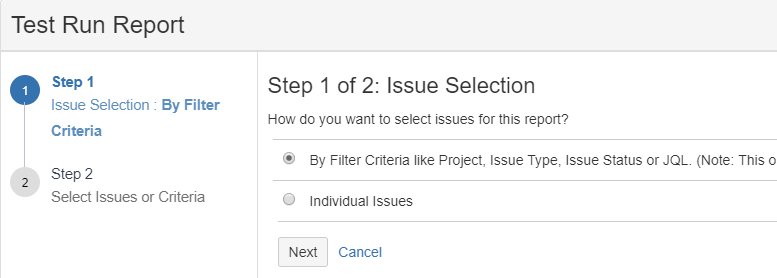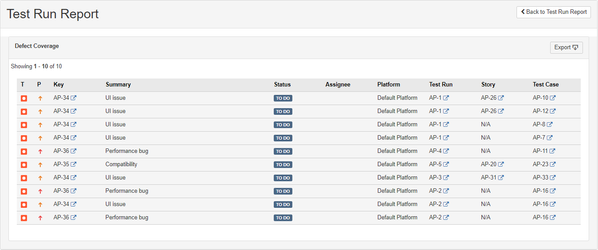Back to QMetry All Products Help Page
How to use Test Run Report?
Introduction
This Test Run Report shows how many tests were run over a period of Time, Sprint or Version.
The report consists of two charts: Test Run Coverage of selected stories and Defect Coverage of selected stories. Select test runs you want to generate the report for. Multiple options are available to filter test runs and select the required ones.
Configure Test Run Report
Open QMetry menu > View Reports > Test Run Report.
Click on the Configure button at top right.
Step 1. Issue Selection
(A) By Filter Criteria like Project, Issue Status or JQL. Apply different filter or write JQL query to construct issue selection criteria.
Note: This option will update report dynamically if new issues are added matching the selection criteria.
To search issues with specific criteria, you can apply either Basic Search or Advanced Search.
Basic Search:
- Project
- Status
- Search By: You can search issues either with Issue Key or with Summary. Just select the parameter and enter value in the adjacent search box.
Advanced Search:
You can use JQL to write the search query and get preferred issues as per the criteria. Read more about JQL syntax and how to use JQL for search.
(B) Individual Issues
Check box will be available to select individual issues as per your preference.
Step 2. Select Issues or Criteria
If you have selected (A) above, then apply filter and click Next.
If you have selected (B) above, then select individual issues by selecting the check box. Even you can apply filter here and then select required issues.
Select test runs you want to include in report and click on the Generate Report button at the top right.
On the basis of test runs selected here, the report will be generated.
Test Case Result
The bar chart displays count of test case execution results of test cases covered under stories. The report shows the count of test cases passed, blocked, failed, not executed, etc.
Once you generate the report, you can see that the counts in the table are clickable.
You can drill down each Execution Result and view contents of the test cases covered in the Execution Result.
You can open individual Story page in Jira.
The records are expandable. You can drill down further from test runs to test cases.
Export Test Execution Report: You can drill down to individual category and export the details related to that category into Excel file by clicking on the Export button.
Defect of selected Test Run
The bar chart displays Priority wise count of defect linkages for the test runs. These are the bugs encountered and logged during the execution phase. Once you select test runs as described above, you can view the Defect of selected Test Run report.
You can filter the report further by its Test Case Status. Select required option on the Test Case drop-down menus above the chart.
The counts in the table are clickable. You can drill down each Priority and view contents of the defects (bugs) covered in the test run.
The report displays total number of unique defects instead of duplicate count. This is unique defect count, which calculates linkage of defect only once even though a single defect is linked multiple times.
For example, the chart displays 3 defects with Medium priority are logged. When you drill-down the count, it shows total 5 defects out of which one defect is linked thrice in 3 different test runs.
Hence, the report shows count of 3 distinct defects logged in test run.
You can view the complete hierarchy of association – Bug – Test Run – Story – Test Case.
You can open individual defect page in JIRA.
Export Defect Coverage Report: You can drill down to individual category and export the details related to that category into Excel file by clicking on the Export button.
Syncing Report Data
Click on the Refresh icon at the top to sync the report data with data updated in JIRA. The data of stories and test runs, which you selected to generate reports, are updated with the latest changes. The report is generated anew with the updated data.
Back to QMetry All Products Help Page






